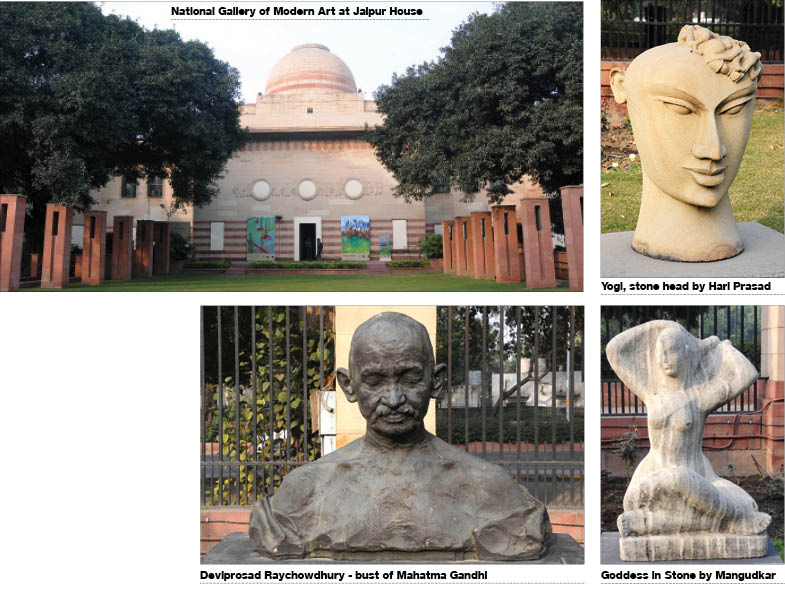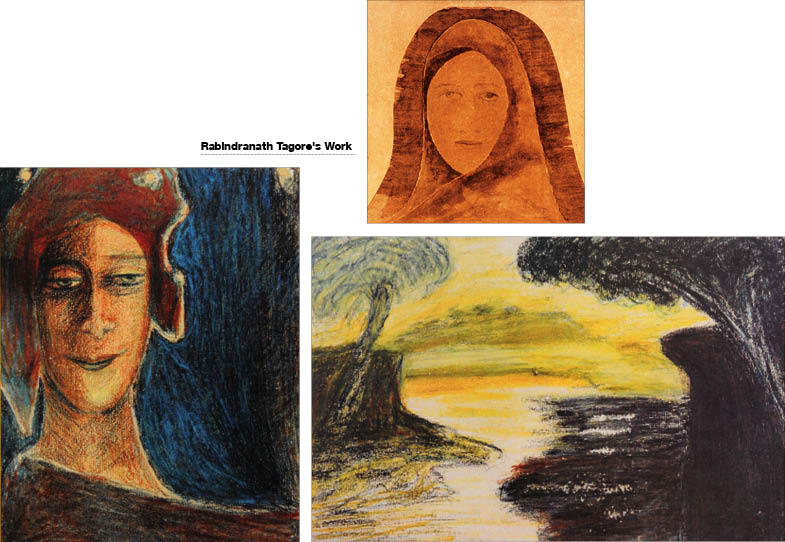New Delhi's NGMA (National Gallery of Modern Art) at Jaipur House is currently showcasing a major retrospective of powerful, sublime, sun-drenched landscapes and other paintings by the great Bengal School pioneer artist Gopal Ghose (1913-1980). This body of 220 evolved artworks, marking the brilliant painter's birth centenary on Dec. 5th, are on display until 20th January. The retrospective is an important storehouse of a significant modern 20th-C. Bengal School oeuvre that merits careful viewing. Parallel to this valuable Gopal Ghose exhibit—which has been titled A Jubilant Quest For The Chromatic—is another profound collection of National Treasure paintings: of Rabindranath Tagore's art and drawings, titled The Last Harvest, and curated by Prof. R. Sivakumar.
It is imperative in today's world to spend some time absorbing the highest of fine art, with its healing spiritual energies. We should reflect on the simple, non-materialistic, idealistic lives led by our nation's greatest artists. Where has such aesthetic truth and beauty disappeared? Our Modernist teachers were untainted, brave souls – choosing to work within uncorrupted, peaceful, ashram lifestyles. The rejection of urban wiles actually enhanced their Modernism.
One is struck by the purity and grace of these great artists' intense immersion in Prakriti – with Beauty and Truth as their Muse. It is in such uncompromising necessary life-choices that the most elevated and meaningful levels of creativity reside. The social significance of the ongoing NGMA exhibits is profound.

The National Gallery of Modern Art is India's leading art gallery. It was established on March 29, 1954. Housed in what was previously the residential palace of the Maharaja of Jaipur, this imposing New Delhi museum contains 15,000 modern artworks from the mid-19th-C onwards. More recently, in 2009, a new wing was added, with six times more space, an auditorium, a conservation laboratory, a library, research section, a museum shop, and a cafeteria. This necessary 'modernisation' of the NGMA has added greater dimension and potential to what used to be a more traditional display-zone for modern Indian art.
The NGMA's premises also present an inspiring body of sculptures, in its permanent open sculpture-gardens – including masterwork-bronzes by Deviprosad Raychowdhury (1899-1975), such as his magnificently Stirring the Triumph Of Labour (1959), depicting a group of daily labourers in motion – which has become emblematic of India's May Day celebrations; and his moving bust of Gandhi, our father of Ahimsa and Freedom, immortalised in a moment of intense meditation. These two bronze artworks are symbolic of what Modern India must remember and strive for today. Among other noteworthy sculptures in the NGMA Gardens are a harmonious Goddess in Stone by Mangudkar (b.1931), and Yogi, a lyrical 1997 stone head by Hari Prasad.
The Gopal Ghose Exhibition has been culled from private collections of the artist's family, Manoj Datta, the Neerja and Mukund Lath Collection of Aakar Prakar Gallery Kolkata, and Abhishek Poddar. Describing his curatorial journey documenting Ghose's oeuvre, the Santiniketan-based Dr. Sanjay Mallik said the following: "In the mid-1990s I was engaged in documenting the visual arts of the 1940s for my doctoral research. It was then that I became aware of the vast range and diversity that constituted Gopal Ghose's artistic oeuvre. I had the opportunity to examine a substantial cross-section of his works, that were carefully preserved by his family in his Kolkata residence. Gopal is identified by a signature-style marked by brilliant passages of pure hue, and the elan of flourish in calligraphic lines."
As a painter and an art-theoretician, I have always been inspired by the poetic purity of Gopal Ghose's art. The freedom and joyousness of his Kalighat-calligraphic strokes, and his spontaneous folk-inspired palette of vibrantly-Bengali celebratory hues, comprises a uniquely emotional style that I would describe as 'instinctively Modernist'. Born on 5 Dec. 1913 in Shyambazar, North Calcutta, the prodigious Gopal spent his childhood shifting between the hills of Simla and the historic cities of Benaras and Allahabad. Such vistas provided him with an intensely-evocative visual and spiritual base. By 1930 the young artist had joined India's Nationalist Movement, and became a student of Deviprosad when he enrolled at the Government School of Art, Madras.
In his unfolding career as an artist of notable originality, Gopal Ghose received appreciative recommendations from such leading personalities as Rabindranath Tagore, Abanindranath Tagore, Nandalal Bose, and the art-historian Stella Kramrisch. In this NGMA Retrospective one is mesmerised in particular by Ghose's flamboyant watercolours and transcendent mixed-media Landscapes. With their free-flowing strokes executed boldly in an Indian-Fauvist palette, these landcapes actually seem to be precursors of the Modernist Souza's 'Futuristic' vistas. Gopal Ghose's blazing red blossoms and fiery yellow summer trees rightly place him as our own most elevated romantic painter. His Expressionist brushstrokes reveal the sensitivities of a Van Gogh.

The Gopal Ghose collection also contains an exquisite, rare Crystal Glass Etching titled Monkeys—standing 16.4" x 5.5" in dimension—a timelessly-etched modern Flacon depicting monkeys at play, sketched skilfully by the artist on fine glass. Some significant Ink Drawings include a marvellously potent depiction of Goddess Durga, incorporating Ghose's calligraphy, where he faithfully invokes Durga as Sri Sri Durga. Two stylised ink-portraits of his charming pet cats are beautifully sketched, in quintessential Kalighat brushstrokes. The entire collection contains immense treasures of the painter's highly-influential Bengali idiom, well-chronicled with a visual timeline of the artist's journey.
Elaborating upon the Tagore exhibition The Last Harvest—which showcases about 208 artworks by Tagore collected from Rabindra Bhavan, Kalabhavana and the NGMA itself—curator R. Sivakumar emphasised the relevance of Rabindranath's art in modern society. In his words: "Tagore was open-minded. He was in contact with other cultures, and believed that we should have the ability to accept them and make them our own. The value of art lies not just in its style, colour or technique, but also on how it can be used by society. Tagore started painting when he was 63, in the year 1924, and continued till his death. He was burdened with many commitments, so it was difficult for him to take time out exclusively for painting. But he desired to paint all the time. In 13 years he made about 2000 paintings. Thus, the title—The Last Harvest—is apt.”
In Tagore's last years, the poet sought the highest-possible freedom of creative expression – he turned maturely to the depths of 'visual silence', in a new painterly lexicon. Tagore's haunting Portraits of his Muse stand in a visual genre all their own. The NGMA show provides an excellent body of such brilliant artworks. Rabindranath's eternal, ethereal and mysterious Muse was his sister-in-law Kadambari Devi, who took her own life at a young age – lonely and disillusioned by the pretences of an arranged marriage and upperclass urban life. This solitary, misunderstood woman's tragic and mystical direct gaze haunts and suffuses all of the poet's poignant portraits. Tagore's landscapes too stand exclusively in a genre of their own: mysterious, magnetic, drawing the viewer into unexplored and life-changing psychic-poetic realms.
I have observed that Tagore used the subtlest of palettes in his art, indicating a mastery and a unique sense of colour that I have described as a 'Poet's Palette'.
Blending organic tones of red-earth, sepia, sap green, golden-ochre and mystic neelambari-blue, along with all the subtle cross-hatches of the dark pen-and-inks with which he had always hand-calligraphed his amazing poetry, Rabindranath evolved a brooding, mesmeric, individualistic painterly style of his own – one that neither existed before him or since.
By presenting such profound inner visions of India's creative giants—Tagore, Gopal Ghose and Deviprosad—the NGMA provides one with an intricate and inspiring aesthetic experience this winter season. These Exhibitions must not be missed.

Read More...